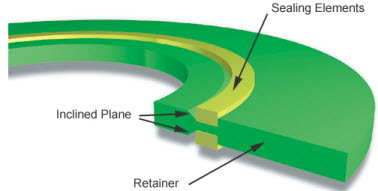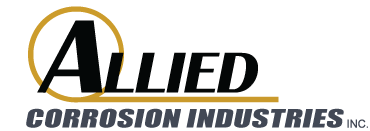1550 Cobb Industrial Dr. | P.O. Box 9098 | Marietta, GA 30065-2098
770-425-1355 (Phone) | 770-425-1354 (Fax) | info@alliedcorrosion.com (Email)
©2018 Allied Corrosion. All rights Reserved.
Made with ❤ by Mighty Good Marketing
Selected:

LineBacker® sealing gaskets utilize a rectangular sealing element, referred to as a “quad” ring, in combination with a unique groove design to effectively seal and isolate flanges of all types. With the unique “quad” ring design, elastic memory is provided for elastomers not normally associated with this characteristic. Materials such as AFLAS, TFE (Teflon) and KALREZ may therefore be used as sealing elements which dramatically increases the options available for matching gasket materials to service and environmental conditions. This greater variety of materials also provides excellent temperature and chemical range compatibility. LineBacker® sealing gaskets are self energizing with theoretical near zero “m” and “y” factors resulting in effecting a positive seal without excessive bolt loads required with flat gaskets.
Significant chemical and material composition improvements have provided an opportunity for the development of three gaskets, designed to address the regulations associated with asbestos substitute gaskets and fugitive emissions. LineBacker® 250 gaskets are manufactured from proprietary materials that provide excellent resistance against environmental leakage without the health hazards associated with asbestos type gaskets.
Benefits and Features
Sizes
Pressure Ratings
| Before Tightening The flange faces come into contact with the sealing elements, which extend slightly above the surface of the retainer. As the flange is tightened the sealing elements are compressed and move sideways into the inclined portion of the groove, developing a high unit pressure against the flange faces. |
 |
| After Tightening The flange faces have come into firm contact with the retainer, thus encapsulating the sealing elements within grooves. At the same time, the unique LineBacker® seal configuration provides elastic memory for elastomers not normally associated with this characteristic – resulting in a simple flat gasket with extremely high loading and self energizing characteristics without adverse cold flow problems. |
 |
 |
 |
The gasket retainer extends out to the O.D. of the flange. Holes are cut in a type “E” gasket at the bolt circle to accommodate threaded studs or bolts. |
The gasket retainer extends out to the I.D. of the bolt circle. |
Asbestos Substitue Problems
The LineBacker® seals better than either asbestos or asbestos substitute gasket under most conditions. The LineBacker® will maintain it’s sealing integrity from hard vacuum to pressures in excess of ANSI and API flange test ratings.
Cost Problems
A positive seal is effected the first time, every time. Time spent in re-tightening or re-seating flanges to compensate for gasket materials cold flow is also eliminated.
The patented design of the LineBacker® permits it to be used with ring joint, flat faced, or raised face flanges; or with any combination of these flanges in a given size and pressure rating.
Leak and Blowout Problems
The flange-to-retainer loading and retainer hoop strength, combined with the powerful pressure-energized feature of the LineBacker® is powerful enough to prevent sudden catastrophic gasket failure.
Flange Damage Problem
Near zero “m ” and “y” factors make it possible to effect a positive seal without the tremendous bolt loads that are required with flat gaskets. Choosing retainer materials compatible with the flange materials will reduce potential corrosion problems. Also, the unique design prevents flange galling that can occur with chevron design gaskets.



| ASTM | Test Method |
LineBacker® Zero™ |
LineBacker® 250™ |
LineBacker® 251#8482; |
|---|---|---|---|---|
| D149 | Dielectric Strength Volts/Mil (Short Term) |
500 | 500 | 550 |
| D695 | Compressive Strength (psi) |
25,000 | 50,000 | 50,000 |
| D229 | Water Absorption (percent) |
1.8 | 0.15 | 0.15 |
| D790 | Flexural Strength (psi) |
20,500 | 50,000 | 50,000 |
| D785 | Harness Rockwell “M” |
85 | 110 | 110 |
| D256 | IZOD Impact Strength (Ft. Lbs./In.) |
1.2 | 11.5 | 12.5 |
| D638 | Tensile Strength (psi) |
23,000 | 40,000 | 45,000 |
| D32 | Shear Strength (psi) |
10,000 | 18,000 | 20,000 |
| F-36 | Compressibility | |||
| F-36 | Recovery (percent) | 1.8 | 2.0 | 2.1 |
| F-38(B) | Creep Relaxation (percent) | 100.0 | 88.9 | 88.9 |
| DIN-3535 | Gas Permeability (cm3/min.) | 0.00 | 0.29 | 0.43 |
| DIN 52913 | Stress Relaxation | N/A | 49.4N/mm2 | N/A |
| Temperature Range Degrees Farenheit |
-60 to +220 | -60 to +350 | Cryogenic to +250 | |
| Temperature Range Degrees Celsius |
-51 to +104 | -51 to +177 | Cryogenic to +121 | |
| Medium | LineBacker® Zero⁜ |
LineBacker® 150⁜ |
LineBacker® 151⁜ |
|---|---|---|---|
| Ammonia | R | R | R |
| Ammonium Hydroxide | F | F | R |
| Benzine | R | R | R |
| Butane | NT | NT | R |
| Calcium Hydroxide | U | U | R |
| Crude Oil | R | R | R |
| Dilute Acids | R | R | R |
| Dilute Caustics | U | R | R |
| Ethanol | NR | NR | R |
| Gasoline | R | R | R |
| Hydrocholric Acid 20% | R | R | R |
| Hydrogen | NT | NT | R |
| Hydrogen Sulfide | NT | NT | R |
| Jet Fuel | R | R | R |
| Kerosene | R | R | R |
| Methanol | R | R | R |
| Naptha | R | R | R |
| Natural Gas | R | R | R |
| Nitric Acid 10% | U | U | R |
| Nitric Acid 20% | U | U | F |
| Potable Water | NR | NR | R |
| Propane | R | R | R |
| Salt Brine | R | R | R |
| Sea Water | R | R | R |
| Sewage | R | R | R |
| Steam to 350°F | U | R | U |
| Steam Condensate to 250°F | U | R | F |
| Sulfuric Acid 10% | U | U | R |
| Tolulene | F | F | R |
| LEGEND: R = Resistant – • – NR = Not Recommended – • – F = Fair U = Unsatisfactory – • – NT = Not Tested |
|||
| The foregoing performance data are intended as guidelines only. Performance suitability for any specific applications should be determined by the user. Variation in temperature, pressure, concentration, or mixtures acting synergistically may preclude suggested service use. Material selection is at the sole risk of the user. Consult with a specialist or Allied Corrosion Industries for specific applications. PSI’s responsibilities will be limited to those listed in the PSI standard warranties. |
|||



To order LineBacker® Sealing/Isolating Gaskets please indicate the following:
Manufacturer’s warranty statement will be supplied upon request to Allied Corrosion Industries, Inc.
Significant chemical and material composition improvements are now being incorporated into sealing gaskets designed to address the regulations associated with asbestos type gaskets. Three versions are manufactured from new proprietary materials that provide excellent resistance against environmental leakage (zero environmental leakage) without the health hazards associated with asbestos type gaskets. All are available as either “E” or “F” type gaskets in isolating retainer materials.

1550 Cobb Industrial Dr. | P.O. Box 9098 | Marietta, GA 30065-2098
770-425-1355 (Phone) | 770-425-1354 (Fax) | info@alliedcorrosion.com (Email)
Made with ❤ by Mighty Good Marketing
We care about your privacy! In order to run a successful website, we are setting cookies and accessing and storing information on your device for various purposes. By continuing to browse this site, you are agreeing to our use of cookies.
If you wish to disable cookies, please visit our Privacy Policy for more information.
Got It! Thanks!Privacy policy